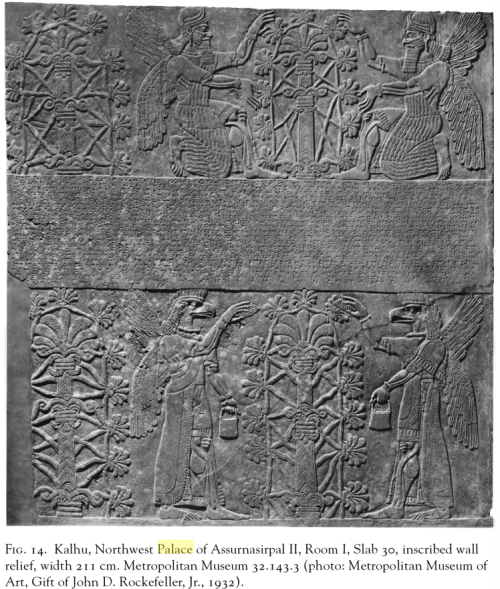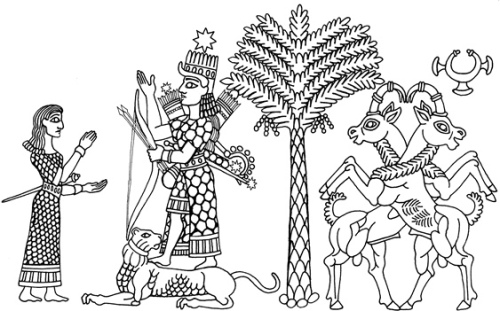Kvanvig: The apkallus as Watchers and Guardians
“As demonstrated in the rituals, the apkallus were not only figures of the past. Surely, they visited the earth in antediluvian time to bestow wisdom on mankind, but they were still alive and invisibly present in the human world.

Detail from a drawing of a bronze plaque held in the Louvre.
Puradu-fish apkallu minister to an ill patient in bed. The lamp of Nusku is depicted at far left, and ugallu attack with upraised fists in concert with Lulal, identified by Wiggerman as “a minor apotropaic god.”
I believe that this plaque portrays an exorcism.
Drawn by Faucher-Gudin, from a bronze plaque of which an engraving was published by Clermont-Ganneau.
The original, which belonged to M. Péretié, is now in the collection of M. de Clercq.
http://www.gutenberg.org/files/17323/17323-h/17323-h.htm#linkBimage-0039
They were present as “guardian spirits,” as we have seen in the depiction of the sick man. We now see that they performed other roles as well. One of the most important was to purify the Tree of Life. This duty was closely connected to their role as cosmic guardians and formed a parallel to the maintenance of the divine statue, as in the Poem of Erra.

Click to zoom in.
Ummanu and bird-apkallu tend the sacred tree.
The bird-apkallu are portrayed in the iconic act of purifying or pollinating the sacred tree with mullilu cones and banduddu buckets.
A fleur de lis is clearly portrayed at the base of the sacred tree. It is not known whether the fleur de lis was also portrayed atop the horned headdresses of the ummanu in the top register.
It is worth noting that the ubiquitous rosette pattern is portrayed at the base of the sacred tree in the top register. The same detail is apparent upon scrutiny of the sacred tree in the lower register, partially occluded by a mount or platform for the tree.
One further detail which may be of no import: the bird-apkallu on the right wears a bracelet, but unlike other bracelets portrayed on left wrists elsewhere in this frieze, the rosette is not visible. For whatever reason, this apkallu wore his rosette bracelet oriented towards his body. This could be no more than an oversight by the original artist, or realistic portrayal of a real life model.
From Kalhu, Northwest Palace of Assurnasirpal II, Room I, Slab 30, inscribed wall relief, Metropolitan Museum 32.143.3. Photo Metropolitan Museum of Art, Gift of John D. Rockefeller, Jr., 1932.
John Malcolm Russell, The Writing on the Wall: Studies in the Architectural Context of Late Assyrian Palace Inscriptions, Eisenbrauns, 1999. P. 18.
When the apkallus purified the tree, they “insured the correct functioning of the plans of heaven and earth,” as it was expressed in Bīt Mēseri. The divine and human worlds overlap. The depiction of the sick man did not show the āšipū performing their ritual, but the apkallus, whom they represented.
In the Poem of Erra the human ummanus were called the images of the transcendent apkallus. Since the scholars emulate the role of the apkallus, the Tree of Life scene, with the apkallus, can also be interpreted as a symbolic representation of the scholar’s activity at the court.
The Tree of Life represents the king, whom the scholars protect with their wisdom. In many of the letters that Parpola has edited this is expressed through a recurring phrase: massartu ša šarri nasāru, “to keep the king’s watch.”

Click to zoom in.
This reproduction of the bas reliefs in Room I of the Northwestern Palace of King Ashurnasirpal at Nimrud is remarkable for the sheer number of apkallus portrayed interacting with endless renditions of the sacred tree.
All apkallu are winged, even the beardless specimens in I-16. All others are either bearded males, or griffin-headed bird apkallus.
Samuel M. Paley and R.P. Sobolewski, The Reconstruction of the Relief Representations and Their Positions in the Northwest Palace at Kalhu (Nimrud) II. (The Principal Entrances and Courtyards). Mainz am Rhein: Verlag Philipp von Zabern, 1992.
From Mehmet-Ali Atac, The Mythology of Kingship in Neo-Assyrian Art, Cambridge University Press, 2010, p. 100.
In the Akkadian phrase the element of “watching” is expressed twice, both through the noun massartu, and through the verb nasāru. The Akkadian massartu both has the connotation “guard, watchman, be awake,” and someone who watches for astronomical observation.
The noun corresponds closely to the verb nasāru, “guard, take care of, keep watch for celestial phenomena.” Used together in massartu nasāru, the phrase often means “to take care of a person’s interests.”
The two meanings “guard” and “watch for omens” come together in the tasks of the scholars; it was through their watching for divine signs that they guarded the king. A good illustration of this double meaning we find in the following letter:
“To the king, our lord: your servants, the scribes of Kilizi. Good health to the king, our lord! May Nabu and Marduk bless the king.
We watched the moon; on the 14th day the moon and the sun saw each other. (This means) well-being.
May Nabu and Marduk bless the king. Because of the ilku-duty (state service) and the corvée work we cannot keep the watch of the king, and the pupils do not learn the scribal craft.”
(Letter 143, Parpola, Letters from Assyrian and Babylonian Scholars, p. 111.)
The role of the earthly scholars at this point reflects the apkallus, as we have seen in many other instances. The scholars were “watchers” over the king’s well-being and health and in this instance over his kingdom, in the same manner as the apkallus who were invoked as “watchers” in the rituals.
The scholars should watch the king in order to maintain the cosmic order, just as the apkallus were watchers of the cosmic order in the divine realm.”
Helge Kvanvig, Primeval History: Babylonian, Biblical, and Enochic: An Intertextual Reading, Brill, 2011, pp. 144-6.




